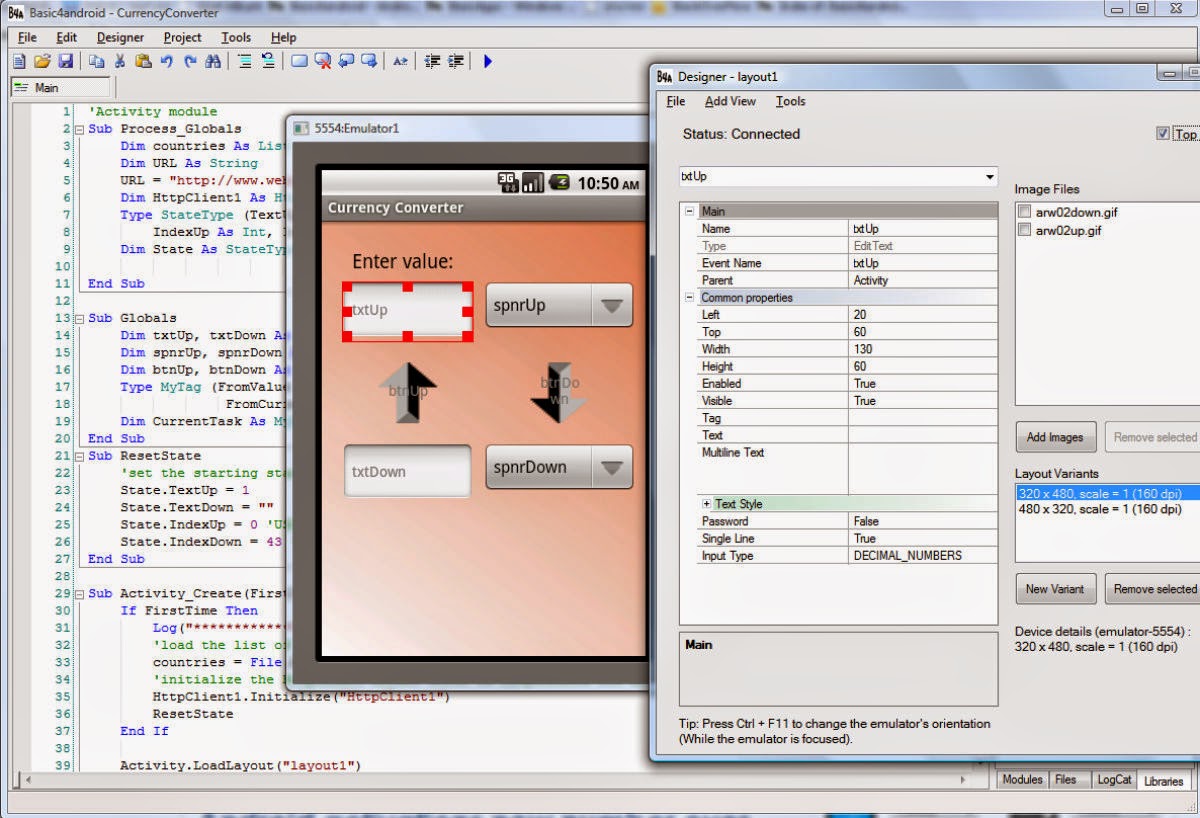

- #BASIC4ANDROID SQLITE TUTORIAL PDF#
- #BASIC4ANDROID SQLITE TUTORIAL DRIVER#
- #BASIC4ANDROID SQLITE TUTORIAL FULL#
- #BASIC4ANDROID SQLITE TUTORIAL REGISTRATION#
#BASIC4ANDROID SQLITE TUTORIAL FULL#
The full code for those routines will be: Sub ButtonRetrieve_MouseClicked (EventData As MouseEvent) Pre-set the possible queries in the ASP script and then choose one of the queries by setting a parameter in the Http request. Instead we will use HttpUtils to connect to a simple ASP.NET script that will issue the query and return the result as a JSON string. This is done by adding two more subroutines: Android cannot directly connect to the database server. TableViewQueryResult.SetColumnHeader(0, "Department Id") TableViewQueryResult.SetColumnHeader(1, "Deoartment Name") TableViewQueryResult.SetColumnHeader(2, "Department Head Id")įinally we have to define some actions to be done for our buttons, when any of them is clicked. ("ASAQueryResult") 'Load the layout file. Private sql As SQL Private ButtonExit As Button Private ButtonRetrieve As Button Private TableViewQueryResult As TableViewĪnd in the AppStart suboutine, the following lines (as shown in bold bellow): Sub AppStart (Form1 As Form, Args() As String) In the Process_Globals we should add the following delarations as shown in bold bellow: Sub Process_Globals #AdditionalJar: jodbc4 #AdditionalJar: sajdbc4 In the Region Project Attributes we will have to add “reference” to the two additional jar, as shown in bold bellow: #Region Project Attributes The code for GetDepartmentsList subroutine will be the following: Sub GetDepartmentsList()Ĭursor = sql.ExecQuery("select * from GROUPO.Departments") The code for subroutineDisConnectFromDB will be the following: Sub DisConnectFromDB() Sql.Initialize("", "jdbc:sqlanywhere:DSN=SQL Anywhere 16 Demo UserID=dba Password=sql ")
#BASIC4ANDROID SQLITE TUTORIAL REGISTRATION#
See 47 CFR Part 17 for information concerning prior registration of. The code for Connect2DB subroutine will be the following: Sub Connect2DB() B4a Site IDs should be provided only for applications relating to VSAT. We have two buttons, named ButtonExit & ButtonRetrieve and a TableView named TableViewQueryResult, in our case. Our applications will contain the following subroutines:Īlso it will contains a basic form with two buttons and a TableView (see screenshot bellow): For the purpose of our example we will use the sample database provided with SQL Anywhere 16. If all steps mentioned before are done, then we are ready to write our first application in B4J to connect and query a SQL Anywhere Database.
#BASIC4ANDROID SQLITE TUTORIAL PDF#
database b4a book pdf b4a sample codes basic4android book pdf download Basic4Android 9. Those files are provided with SQL Anywhere client installation. B4a tutorial pdf Read Online > Read Online B4a tutorial. To use it in B4J we have to copy the sajdbc4.jar & jodbc4.jar to our additional libraries folder.
#BASIC4ANDROID SQLITE TUTORIAL DRIVER#
SQL Anywhere does provide a JDBC driver (sajdbc4.jar).

To connect to a database we need to have a JDBC driver. So we need to have installed SQL Anywhere 16 (Developer Edition) to our computer.įirst thing we must have in mind is that B4J produces java code. The database we will use is SQL Anywhere 16 (Developer Edition). = Str($res.In this post we will see a Database Connection example in B4J. SQLiteViewer: working demonstration of Android database browser using DBUtils. PUBLIC SUB GridView1_Data(Row AS Integer, Column AS Integer) ThreeActivityExample: Three Activity Example. 'change the rowcount of the gridview from 0 to the number of records. Sql = "select s_seq as ID, s_rndm as Value from sampleTable" On Gambas you need nothing more than a gridview (gridview1) on an otherwise empty form (You could also instantiate the gridview from code.

The process is as follows:ġ Deletes a file test.sqlite in the users home directory (if it exists).Ģ Creates an SQLite database test.sqlite and defines a table sampleTable with two integer fields, one a sequence (yes, I know SQLite does that internally anyway!) and the other a random number.ģ Fills the table with 10000 records with rollback.Ĥ Displays the results in a gridview using the data handling event already described in a separate section. Here is a little program I wrote some time ago to demonstrate the creation of a database from within Gambas.


 0 kommentar(er)
0 kommentar(er)
